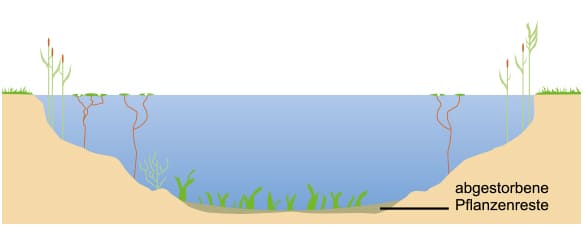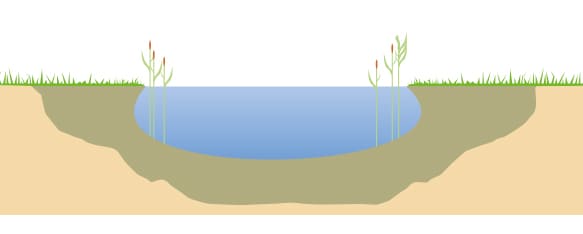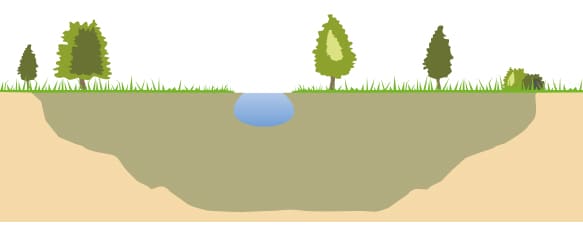Silting up of a lake - Low-level moor
There was once a lake in the flat area
between the hill on which the historic
center of St. Veit is located and the
northern mountain slope. From the Bronze
Age, for example, there are indications
that the roofs of the houses were covered
with reeds. However, the lake silted up
over time and a fen formed. Although
every lake generally silts up over time, this
development is only noticeable to us in
relatively small and shallow lakes. A lake
where you can observe the silting process
is lake Goldeggersee.
The silting up process begins with dead
plant parts collecting at the bottom of the
lake and mud building up. At the same
time, land plants are encroaching from the
shore.
As the lake becomes shallower, the light
soon reaches the bottom and more plants
grow in the lake. This dense vegetation
and higher temperatures reduce oxygen
levels, further slowing decomposition.
The dead plant remains increase and peat
forms. Eventually, moisture-loving trees
such as alders and birches also invade the
moor and a fen forest can form.
Kids
What is traditional costume?
Austrian traditional costume is a traditional dress worn in Austria on special occasions such as folk festivals, weddings and public holidays. Girls and women often wear a dirndl, a beautiful dress with an apron and a blouse, while boys and men wear lederhosen with shirts and socks, i.e. long knitted socks. This festive and skilfully designed clothing shows the culture and history of Austria and reminds people of their traditions and those of their ancestors. Tracht used to be the working clothes of people in the countryside.
Today, traditional costumes make people proud of their origins and culture, and their colourful patterns and embellishments often show which region of Austria the wearers come from.
What is traditional costume?
Austrian traditional costume is a traditional dress worn in Austria, especially on special occasions such as folk festivals, weddings and public holidays. This clothing has a long history and shows the culture and customs of the different regions of Austria. Tracht used to be the working clothes of people in the countryside.
Women and girls often wear dirndls, which consist of a dress, an apron and a blouse, while men and boys wear lederhosen, often combined with shirts, socks and sometimes waistcoats or hats. Traditional costume is often colourful and decorated with elaborate patterns. It serves not only as festive clothing, but also as a sign of pride in one's origins and traditions.
What is traditional costume?
Austrian traditional costume is traditional clothing that is deeply rooted in Austria's culture and history and is worn on special occasions such as folk festivals, weddings and public holidays. Tracht used to be the working clothes of the rural population. Nowadays, it is impossible to imagine festivals and celebrations in Austria without traditional costume.
These traditional costumes vary depending on the region and consist of a dirndl, a dress with apron and fine blouses for women and lederhosen for men, often combined with shirts, waistcoats and hats.
Traditional costumes are known for their bright colours and ornate decorations, which often reflect regional characteristics. Wearing traditional costume symbolises pride in one's origins and the cultivation of centuries-old traditions, which promotes a strong sense of community and a connection with one's own culture.



